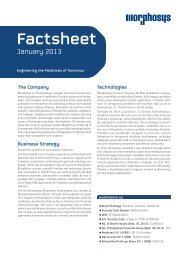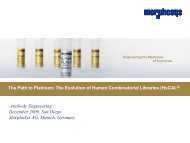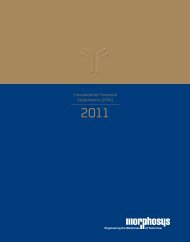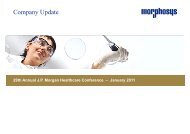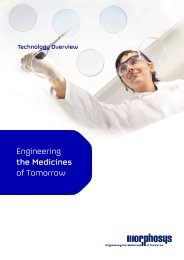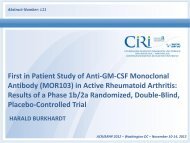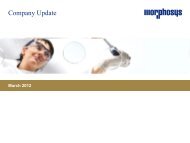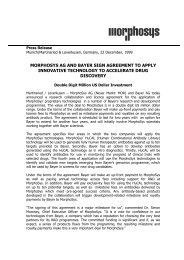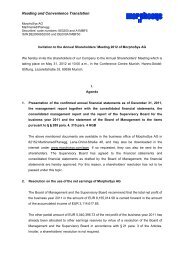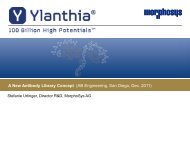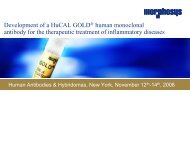Transcript of Speech and Q&A Conference Call Q2 - MorphoSys
Transcript of Speech and Q&A Conference Call Q2 - MorphoSys
Transcript of Speech and Q&A Conference Call Q2 - MorphoSys
Create successful ePaper yourself
Turn your PDF publications into a flip-book with our unique Google optimized e-Paper software.
treatment <strong>of</strong> Alzheimer’s disease, the data is <strong>of</strong> limited relevance to gantenerumab. The main<br />
reason for this is that the two antibodies are being tested in different patient populations.<br />
Whereas the ongoing phase 3 trials <strong>of</strong> bapineuzumab are being conducted in mild- to<br />
moderate Alzheimer’s disease patients, gantenerumab is being developed in prodromal, or<br />
early stage sufferers. This is an important difference, which reflects current underst<strong>and</strong>ing <strong>of</strong><br />
the disease, namely that once symptoms appear, it may be too late for therapeutic<br />
intervention, <strong>and</strong> that the best chance <strong>of</strong> treatment is to intervene at the earliest possible<br />
opportunity, to prevent the damaging effects associated with the build-up <strong>of</strong> �-amyloid<br />
plaques.<br />
Gantenerumab is the most advanced antibody being developed in this way. Needless to say,<br />
the medical need <strong>and</strong> commercial opportunity are enormous.<br />
Slide 7: Partnered Pipeline: Selected Phase 2 Programs - Outlook<br />
While gantenerumab is the first partnered compound to enter late-stage clinical development,<br />
several programs have the potential to progress to this stage fairly quickly. More specifically,<br />
various active phase 2 studies for three Novartis compounds - including BHQ880 in cancer<br />
<strong>and</strong> BYM338 in musculoskeletal diseases – as well as the Janssen compound CNTO888 in<br />
IPF are scheduled for completion by the end <strong>of</strong> this year. As a result, we could see clinical<br />
data being published by our partners for a number <strong>of</strong> these studies. Success in Phase 2<br />
could also mean <strong>of</strong> course additional Phase 3 programs adding maturity to our pipeline.<br />
Slide 8: <strong>Q2</strong> 2012: Pipeline Update – Partnered Pipeline (II)<br />
Regarding other partnered programs, there were several developments during the second<br />
quarter.<br />
First, our partner OncoMed presented data on both currently ongoing HuCAL antibody<br />
programs during <strong>and</strong> after the end <strong>of</strong> the quarter. Most importantly, phase 1 data on the anti<br />
Notch antibody OMP-59R5 presented at ASCO showed that the antibody was generally safe<br />
<strong>and</strong> a maximum tolerated dose was established. For OMP-18R5 OncoMed published<br />
preclinical data demonstrating potent anti-cancer activity <strong>and</strong> synergistic activity with<br />
st<strong>and</strong>ard-<strong>of</strong>-care chemotherapeutic agents <strong>of</strong> the antibody in multiple human tumor models.<br />
Second, as reported on clinicaltrials.gov, a phase 2 study by Novartis evaluating the safety,<br />
tolerability <strong>and</strong> efficacy <strong>of</strong> BYM338 in patients with sporadic inclusion body myositis has been<br />
completed. This HuCAL antibody is also the subject <strong>of</strong> a further two phase 2 trials.<br />
Third, our partner Bayer HealthCare received orphan drug status in the US for BAY94-9343<br />
for the treatment <strong>of</strong> mesothelioma. This drug c<strong>and</strong>idate is an antibody-drug conjugate<br />
comprising a HuCAL antibody against the target mesothelin, linked to a maytansinoid toxin.<br />
The program is currently in Phase 1 development.<br />
To complete the updates on partnered programs, our partner Janssen has reported<br />
commencing a new phase 2 trial <strong>of</strong> the HuCAL antibody CNTO1959. In this study,<br />
CNTO1959 will be compared with the marketed antibody Stelara in about 250 rheumatoid<br />
<strong>MorphoSys</strong> AG <strong>Q2</strong> 2012 <strong>Conference</strong> <strong>Call</strong> Manuscript Page 3 <strong>of</strong> 17




